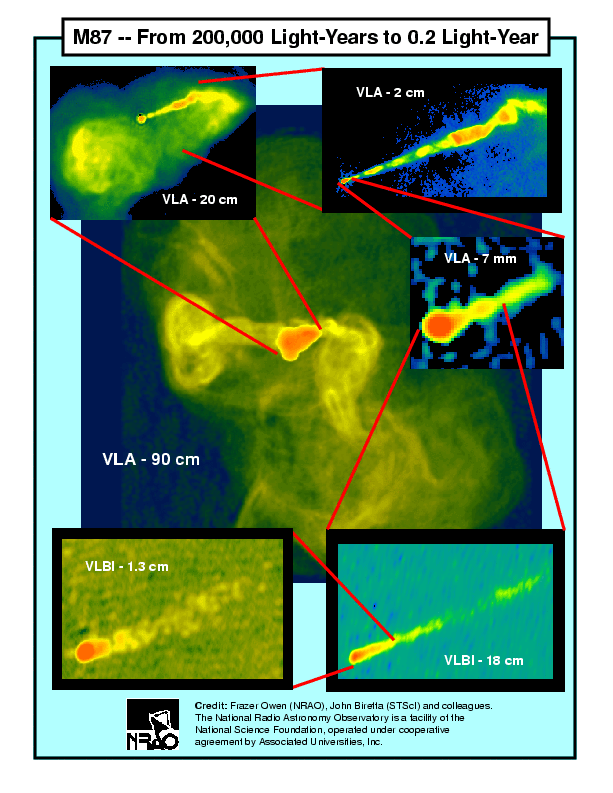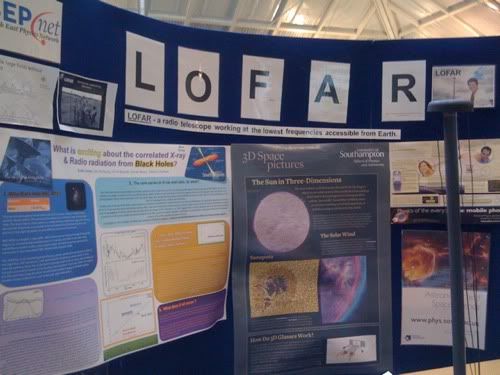I gave the talk to an after-school astronomy club, consisting manily of year 9's on an accelerated GCSE program. There were 7 students present and their teacher. The talk was ~45-50minutes long with questions at the end which lasted a further 15 mins. The students also asked many questions during the talk.
Talk Overview
The talk was mainly about Radio Astronomy in general and why LOFAR is such a new exciting telescope. I begin with why I myself got into astronomy, from my GCSE's, then into the electromagnetic spectrum, explaining that radio has the longest wavelength.
Talking about radio waves follows into my radio research using the Very Large Array (VLA) telescope in New Mexico, USA . I try to explain how interferometry works. High angular resolution is particularly important for looking at the active galaxies (galaxies with an active centre i.e. jets spurting out from galaxy) because astronomers still don't know how jets work. Seeing deep into the core of the galaxy where the jet is will help astronomers to understand what is happening. I also explain the 2 different types of black holes; supermassive and binary, with a major focus on active supermassive black holes which I study.
 |
| M87- Jet in active galaxy- resolution increasing. |
From my research where I investigate the relations between X-ray radiation from the disk of active galaxies to Radio from the jets of active galaxies, I go into talking about LOFAR.
LOFAR
LOFAR is a real-time multiple sensor array, specifically designed to detect radio emission below 240MHz. It's a revolutionary device in that utilises electronic beam steering rather than mechanical pointing and uses low-cost dipole antenna instead of as the dish type antennas of the VLA. The base of array is in the Netherlands, and when complete will consist of 36 apeture array stations distributed over an area with a diameter over 100km. Several international stations have been built in UK, Germany, France and Sweden, achieving resolutions of 0.2 arcseconds, with the largest baselines across Europe of the order of 1500 kms. I was lucky enough to help build many of the Low Band Antenna (LBA) at the LOFAR UK station during June 2010, (see Image below). One of the Key Science goals of LOFAR is the Epoch of Reinoisation which is the time at the beginning of the universe, when it was a few hundred million years old (about a twentieth of its current age) and objects started to form out of the plasma of the Big Bang!
Square Kilometer Array (SKA)
LOFAR
LOFAR is a real-time multiple sensor array, specifically designed to detect radio emission below 240MHz. It's a revolutionary device in that utilises electronic beam steering rather than mechanical pointing and uses low-cost dipole antenna instead of as the dish type antennas of the VLA. The base of array is in the Netherlands, and when complete will consist of 36 apeture array stations distributed over an area with a diameter over 100km. Several international stations have been built in UK, Germany, France and Sweden, achieving resolutions of 0.2 arcseconds, with the largest baselines across Europe of the order of 1500 kms. I was lucky enough to help build many of the Low Band Antenna (LBA) at the LOFAR UK station during June 2010, (see Image below). One of the Key Science goals of LOFAR is the Epoch of Reinoisation which is the time at the beginning of the universe, when it was a few hundred million years old (about a twentieth of its current age) and objects started to form out of the plasma of the Big Bang!
Square Kilometer Array (SKA)
The location of the SKA has been shortlisted to Australia or South Africa with a decision being made in 2012. This array which will create a telescope with a collecting area equivalent to a dish with an area of about one square kilometre and combines three different type of antenna. It will combine high frequency dishes (like the VLA) with low frquency apeture arrays (like LOFAR) to provide continuous frequency coverage from 70 MHz to 10 GHz and will become the world's best imaging and surveying telescope.
 |
| Having fun after final LOFAR LBA antenna was finished. |
I started the talk at Brookfield by explaining why LOFAR is so different to radio antenna most people are aware of (VLA antenna, dishes). I explained how we built the 96 LBA antenna at the new UK site in Chilbolton, and showed them a video of us making the telescope from YouTube where Professor Bob explains how LOFAR works and about the Epoch of Reionisation. After explaining all about this time in the universe, when the first stars and quasars (black holes) were being created I then tried went on to explain about the Neutral Hydrogen 21cm. It is is this wavelength of Hydrogen which we associate with this time in the universe, but the frequency has been redshifted to low frequencies, below 240MHz and can therefore be detected by LOFAR.
This led me into explaining Doppler shift and showing spectrum where various atomic lines had suffered red or blue shift, I think this part of the talk went over alot of their heads but some of them seemed to understand quite well.
I finished the talk by explaining spin off in Technology from Radio Astronomy. I think it is important to put these in since we need to show how important it is that science and astronomy are not allowed to stop due to government etc cutting the money...I start with the invention of wi-fi which earned Australian astronomers 200 million AU Dollars (all of which they are ploughing back into the new square kilometer array, SKA telescope) . I also talked about Satallite Navigation systems, a spin off from Cambridge radio astronomers trying to find accurate postions of their movable antenna with respect to their fixed antenna to carry out radio interfermetry.
Questions and Thoughts
The majority of questions from the students were about black holes and jets. There were some very good questions about how black holes form in the early universe, as opposed to the normal, end of a star life, and a good question about why a galaxy should rotate in a certain way.
There was only one or two questions about the LOFAR antenna which manily related to the lack of moving parts and why there needed to be so many of them. All questions after talk went off onto a tangent about worm holes, time-travel and E=mc2 and what happens when a black hole comes to the end of it's life....very good questions, shows they were thinking alot during the talk...but maybe not thinking so much about radio astronomy :P... I had a good go at answering all these and explained to them that with regards to jets and exploding black holes, astronomers are still preety clueless, so this is why we need intelligent people like them to become astronomers and help us work it all out . Finally just as I was leaving one boy asked me for advice on buying an optical telescope (which I was unable to help with :P).
Suggestions for Future Talks
Happy overall with science content.
Need more science relating to LOFAR (specifically with the UK antenna that has been added)
Obvious interest in black holes, so tie in black holes to LOFAR.
Better explanation of Doppler and Red Shift.
More stuff on black holes relating to sci-fi stuff, time travel etc.

